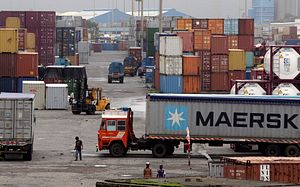The COVID-19 pandemic has been unprecedented on many counts pertaining to public health, national security, and the global economy. Not since the Spanish Flu of 1918 has a pandemic brought economic powerhouses to such a standstill.
Even in its initial stages, when COVID-19 was myopically perceived as a China-specific problem, it was still a global conundrum — for as the finance adage goes, when China sneezes, the rest of the world catches a cold, alluding to China’s position as the factory of the world.
When supply chains in China are disrupted that means supply chains around the world are disrupted. An eclectic mix of companies have been extraordinarily affected as production and distribution networks have gone awry.
But in the midst of this pandemic, as industries stall, there could be another form of disruption, in the sense used in Silicon Valley to signify the winds of change. What winds of change blow toward India?
Narendra Modi’s ascent to power in 2014 and the grand launch of the “Make in India” manufacturing initiative was seen as the coming-of-age of India’s manufacturing potential.
While the initiative can be credited for its ambitious approach, it has been broad-based and lacked policy focus. As India progressed from an agrarian economy to services in the 1990s, the economy skipped the vital manufacturing component that made China the factory of the world.
Though Make in India sought to pitch India as an alternative manufacturing destination to China, a wide-ranging projection of 25 varied sectors, ranging from leather to space, for investment meant emphasis on the big picture at the cost of more specific sectoral details.
Furthermore, the policy has not adequately factored in India’s comparative advantages. As a result, Vietnam and Bangladesh have made the most of arising manufacturing opportunities, particularly as manufacturing costs in China increased as Beijing moved to more of a consumption-driven economy.
The Setting
China has found itself facing global scrutiny since the then-epidemic, now-pandemic erupted in Wuhan, both for its delay in not alerting the world community about its severity as soon as possible and for admonishing doctors and journalists, who served as harbingers of the pandemic.
With the ongoing trade disputes before the COVID-19 outbreak, Washington and Beijing have continuously locked horns. These developments have accelerated global firms’ strategic plans to diversify manufacturing bases away from China, as a way of insuring against supply chain disruptions. Asian economic powers have begun to announce incentives to move production out of China too, with Japan even earmarking a $2.2 billion fund to encourage manufacturers to do just that.
India’s expanding economy and robust middle class provides a lucrative market while its abundant skilled and semi-skilled labor adds to the country’s ability to support bulk manufacturing, assembly, and processing.
Furthermore, India’s overlooked eastern coast is strategically placed to connect with Asia-Pacific markets, an advantage to optimize supply chains and minimize transportation costs.
In addition, India’s cost advantages come alongside its democratic fabric, with an emphasis on transparency and rules-based international order. India’s willingness to meet its supplier obligations without weaponizing trade provides the global business community with predictability and fair trade.
So how can New Delhi capitalize on these advantages and opportunities? The government of India should adopt a phased strategy, prioritizing several immediate, medium, and long-term components.
Get down to brass tacks: In the near term, the government should announce eye-catching schemes to invite companies to manufacture in India’s eastern coast and traditional manufacturing clusters. To set the right tone, government should establish effective communication through business-friendly channels to convey easy availability of land in mega special economic zones (SEZs), ready-to-move-in facilities, sector-specific business-friendly regulations, a simple labor code, tax breaks, and other incentives aimed at bringing its manufacturing competitiveness on par with the most competitive destinations in Asia.
Target the low-hanging fruits: India should aim at targeting low-hanging fruits in the next six-to-eight months, winning major investment deals in sectors where the economy has domestic supply chains. Moving up the value chain is far easier when there is an underlying ecosystem. Targets could include pharmaceuticals, mobile phones, machinery, and other sectors where there is a robust network of small and medium-sized enterprises (SMEs). These rapid early successes will set the momentum in attracting subsequent mega manufacturing investments in other sectors.
Strengthen long-term commercial diplomacy: For the rest of his second term, Modi should place a special emphasis on India’s commercial diplomacy, expanding diplomatic strength in key missions to engage business leaders with increased vigor. Often, India’s commercial offices in prominent missions are understaffed. To this end, the government should enable the lateral entry of some of India’s best private sector professionals with sectoral and negotiating expertise into the diplomatic corps. India should have its best commercial diplomats in friendly capitals like Washington, D.C., Tokyo, Seoul, and Singapore and in missions to important commercial cities, including San Francisco and Osaka, to reinforce India’s position as the next big manufacturing destination.
Can India ‘Make’ It?
It is usually said that India reforms with a crisis, as it did in 1991 with the Balance of Payments crisis. While the economy this time around is in a much better state, the Modi government has a chance to leverage the changing geopolitical tide to catapult India’s manufacturing.
Shortly after the 1991 reforms, a popular song “Made in India” was released by Alisha Chinai; it became a sensation that gave birth to Indi-pop and sold more than 5 million copies. It’s time to rechristen the “Made in India” reference from music to manufacturing and give rise to new industries and create millions of new jobs. Therein lies the hope for India.
Akshobh Giridharadas and Vaman Desai are Directors at BowerGroupAsia based in Washington DC. They advise clients on political and economic risk and strategic market entry in the Asia-Pacific region.

































